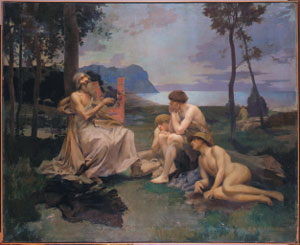|
||
      |
Original Source
Eyes and ears

At the center of Emile-René Menard’s Homer, painted in 1885, sits a curious figure, says art historian Martha Ward. Absorbed in the blind poet’s verse, the young man—leaning forward, head in hands—is lean and lanky, with a shaggy mop and unrefined features. “He’s a ruffian,” Ward says, “a lower-class, rough-hewn type.” Had Menard painted this scene a decade earlier, the youth would more likely have been pushing a plow or herding sheep than listening to poetry. “There’s a whole social dimension to who gets to look and listen in 19th-century French artwork,” Ward says. “Prior to the 1880s, lower-class figures are usually shown engaged in the world they work in, doing quotidian things.” A peasant depicted as part of a landscape “lacks the capacity for aesthetic reflection on it.”
That convention changed as parliamentary democracy took hold in post-Napoleonic France, and as the Symbolist movement grew, emphasizing individual emotion and experience. Says Ward, who studies the history of museums and artwork’s evolving reception among viewers: “In the 1880s there’s a breakthrough.”
Menard’s painting is part of a Smart Museum exhibit slated to open November 6, called Looking and Listening in 19th-Century France. Germinating from a graduate seminar of the same name, the show examines looking and listening by both artistic subjects and viewers of artwork. “The 19th century,” Ward says, “begins to have more emphasis on silent, individual contemplation of works. Paintings get hung at eye level; huge exhibitions give way to more private showings.” Among the artworks included in the exhibit—each with a commentary by Ward, Smart curator Anne Leonard, or an art-history graduate student—are caricatures of Parisian telescope owners, a painting of Joan of Arc hearing the voices that led her into battle, and a picture book intended to teach musical concepts to children.